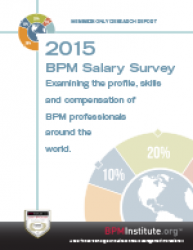There’s a fair amount of excitement around Robotic Process Automation or RPA. Some of it is just hype and some of it has substance. In February of this year, *Forrester forecasted that the size of the RPA market will reach $2.9 billion by 2021 – only to quickly point out that this number pales in comparison to the size of the total Artificial Intelligence (AI) spend estimated at $48.5 billion. Forrester also estimated that there will be over 4 million robots doing office and administrative and sales and related tasks by 2021 and the cost of an RPA robot is currently in the $5,000 to $10,000 range per annum. As a single robot may replace as many as three to five workers – the savings are easy to calculate.** Further, the return on investment (ROI) from RPA has been predicted at a potential of 30–200% —in the first year. ***
Andrew Spanyi
January 5, 2005

Business Process Management (BPM)
Digital Transformation (DX)
Analytics/Big Data
Customer Experience
Operational Excellence (OPEX)
Organizational Change Management (OCM)
Articles by: Andrew Spanyi
4 Critical Factors in Digital Transformation Success
The term ‘Digital Transformation’ has taken its place in today’s business vocabulary. It’s on the lips of virtually every IT vendor, most management consultants and an increasing number of executives.
Customer Experience is the key to Operational Excellence Success
A September 2015 survey of 150 Operational Excellence (Op Ex) professionals found that 38% of respondents listed Customer Experience (CX) as their number one priority in Op Ex. That’s both good news and bad news. The good news is that nearly 4 out of 10 Op Ex professionals recognize that CSX is central to Op Ex success. The bad news is that 62% – don’t.
There’s no doubt that Op Ex success also relies on other factors such as leadership and culture. But if an organization doesn’t put customers first – they may find themselves optimizing to a decreasing share of the market. Op Ex professionals will recognize the importance of focusing on customer experience as it has been part of the lean movement since 1988.
What to Look for in 2017?
According to a recent article in Forbes, there’s a high level of consistency on macro technology trend predictions for 2017 by organizations such as Gartner, Forrester, Deloitte, Accenture, and McKinsey. That’s not surprising as “digital transformation” is pretty much the leading buzzword in today’s corporate lexicon and executives scramble to get up to speed on related concepts such as social, mobile, cloud, artificial intelligence, machine learning, cognitive computing, analytics, and big data.
Taking Operational Excellence to the Next Level
Best in class companies understand that Operational Excellence (Op Ex) is the means to an end and not an end in itself. Yet, many organizations dedicated to Op Ex focus mostly on assuring that the core skills of Lean and Six Sigma are in place and that people understand work as a process. In some cases, companies choose to deploy Op Ex along departmental lines and fail to take full advantage of removing the non-value added steps residing in cross functional handoffs. While building the foundation for Op Ex is important, it’s not enough on its own. A company intent on taking Op Ex to the next level may wish to consider the following four tactics.
Operational Excellence and Superior Customer Experience
Each quarter, the American Customer Satisfaction Index issues an update of overall U.S. customer satisfaction. The national ACSI score for the period 1994 through 2015, as depicted below, reflects an aggregate of customer satisfaction with companies that comprise a large cross-section of the economy.*
BPM Salary Survey – A comparative analysis
A must read for business analysts, business process analysts, business process managers, business process designers and business architects.
This BPM Salary Survey report outlines a regional comparison across the USA, Canada and EMEA (Europe, Middle East and Africa). It is based upon the data collected in the BPM 2015 Salary Survey conducted by BPMInstitute.org which represented the first such survey and formed the baseline for our future research in this area.
What’s the Value Proposition of BPM?
What is the value proposition of BPM and how do I communicate to my senior leadership team is one of the most frequently asked questions on BPM.
In answering this question, the first order of priority is to ensure that people in the organization have a common shared understanding of BPM. In our view, BPM is not just modeling processes, it’s not just launching improvement projects, and it’s not just monitoring process performance for continuous improvement.
Instead, it is all three of these – in other words, the modeling, AND the improvement AND the management of the large cross functional processes in the firm.
Once, a shared understanding of the definition of BPM is achieved, it is then possible to outline the approach, benefits and pitfalls to avoid in BPM to demonstrate the value it can provide.
Some of the key principles and the general approach in BPM are outlined in Table 1 below:
Does Size Matter in BPM?
While controversy may continue to exist on whether size matters in areas as diverse as sex, bacteria and even blue whales – there is little doubt that size matters enormously when it comes to Business Process Management (BPM).
Tackling larger, cross functional processes is at the heart of success with BPM. This applies to both process improvement and process management. The potential size of the prize increases proportionally with improvement efforts targeted at larger, cross functional processes such as inquiry to order, order to delivery, request to receipt and idea to launch as these initiatives target critical non-value added activities across department boundaries.
Process Ownership
The late, great Yogi Berra once said, “Baseball is 90% mental and the other half is physical.” We could say something similar – “process ownership is ninety percent leadership and the other half is management.”
Process ownership was arguably first described by Dr. Geary Rummler and Mr. Alan Brache , in their book ,Improving Performance: How to Manage the White Space on the Organization Chart in 1990. They described the role of process owners as one which intended to “oversee the cross-functional performance of a process.” Note that it did not attempt to “represent a second organizational structure” – instead it was described as a role that emphasized collaboration across organizational boundaries.























